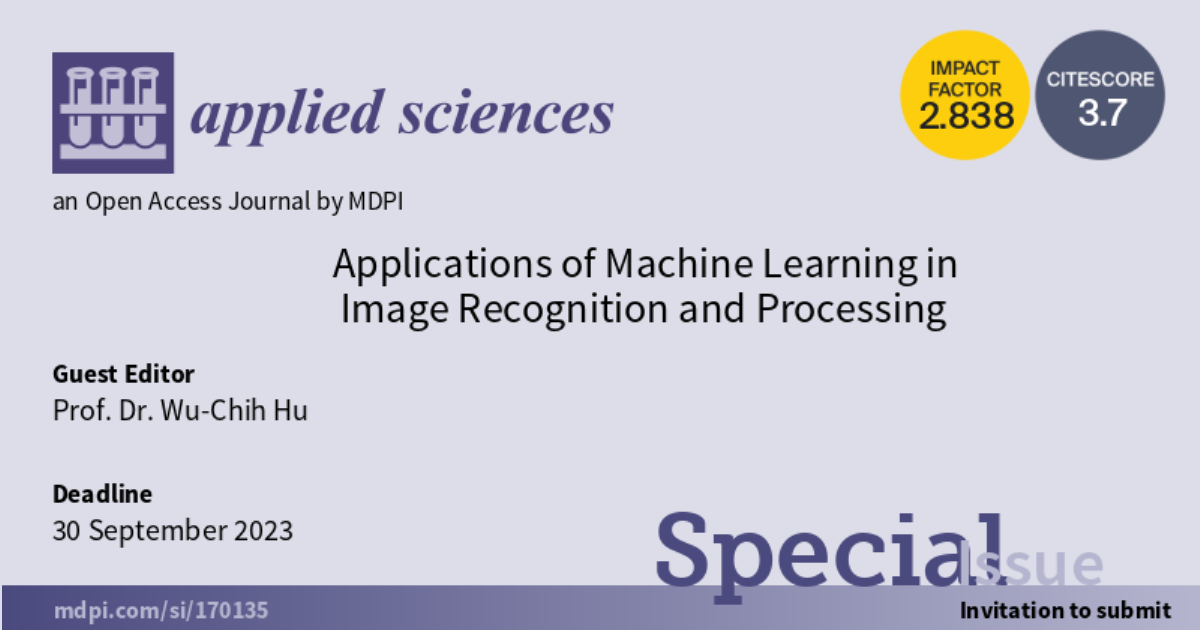Applications of Machine Learning in Image Recognition and Processing
A special issue of Applied Sciences (ISSN 2076-3417). This special issue belongs to the section "Computing and Artificial Intelligence".
Deadline for manuscript submissions: closed (31 December 2023) | Viewed by 3787

Special Issue Editor
Interests: image processing; pattern recognition; visual surveillance; internet of things; big data analysis; deep learning
Special Issue Information
Dear Colleagues,
Due to the fact that image capture software and hardware technology have advanced and became affordable, various fixed devices (such as road photography, intersection monitoring, parking lot monitoring, etc.) and mobile vehicles (such as smart phones, car cameras, unmanned aerial cameras, etc.) can be highly integrated with the communication network, and images and videos are gradually replacing traditional text and audio as part of people's daily work and leisure. This also encourages more R&D personnel to use their creativity to delve into more advanced technologies and systems of image processing and recognition, allowing a variety of innovative image/video value-added applications to be conceived. Furthermore, based on the rapid development of deep learning in recent years, it has had a great effect on the research of image processing and recognition. There are many research topics related to image processing and recognition, covering a relatively large depth and breadth. Therefore, in terms of practical applications, the fields of image/video processing and recognition have experienced substantial growth in the past ten years.
The Special Issue on “Applications of Machine Learning in Image Recognition and Processing” covers the innovative technologies or applications of rising trends in image processing and recognition. Topics of interest include, but are not limited to, the following:
- Small target detection and tracking recognition;
- Crowd counting;
- Biomedical image processing
- Intelligent agriculture;
- Intelligent aquaculture;
- Intelligent transportation;
- Intelligent surveillance;
- Forgery detection and recognition.
Prof. Dr. Wu-Chih Hu
Guest Editor
Manuscript Submission Information
Manuscripts should be submitted online at www.mdpi.com by registering and logging in to this website. Once you are registered, click here to go to the submission form. Manuscripts can be submitted until the deadline. All submissions that pass pre-check are peer-reviewed. Accepted papers will be published continuously in the journal (as soon as accepted) and will be listed together on the special issue website. Research articles, review articles as well as short communications are invited. For planned papers, a title and short abstract (about 100 words) can be sent to the Editorial Office for announcement on this website.
Submitted manuscripts should not have been published previously, nor be under consideration for publication elsewhere (except conference proceedings papers). All manuscripts are thoroughly refereed through a single-blind peer-review process. A guide for authors and other relevant information for submission of manuscripts is available on the Instructions for Authors page. Applied Sciences is an international peer-reviewed open access semimonthly journal published by MDPI.
Please visit the Instructions for Authors page before submitting a manuscript. The Article Processing Charge (APC) for publication in this open access journal is 2400 CHF (Swiss Francs). Submitted papers should be well formatted and use good English. Authors may use MDPI's English editing service prior to publication or during author revisions.
Keywords
- deep learning
- image processing
- image recognition
- intelligent application





